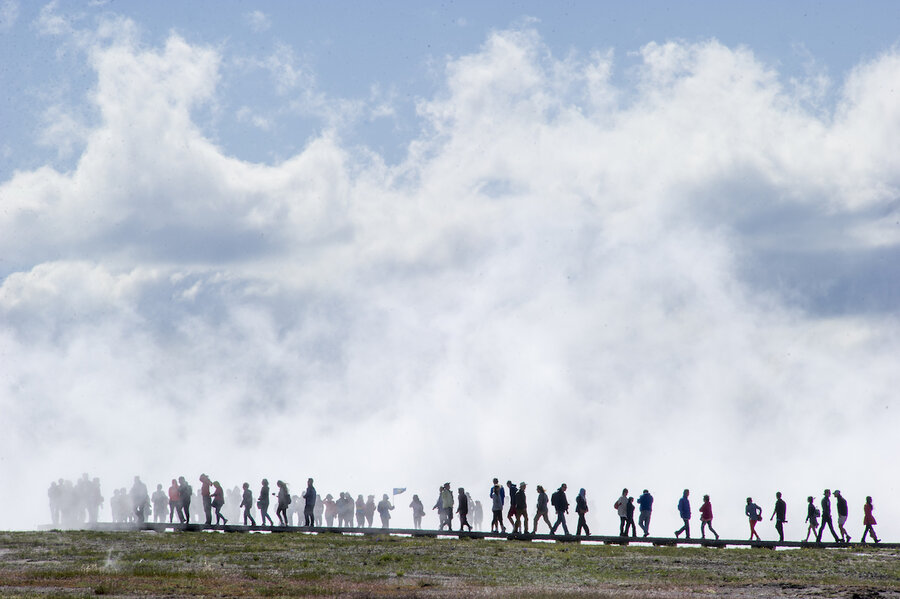Resolving to share ‘America’s best idea’
Loading...
On Day One we took a wrong turn. OK, we took several wrong turns. But on this particular turn, we were seeking the iconic lower falls in the Yellowstone River’s grand canyon. With no canyon in sight, we hustled along in a park that’s bigger than Delaware and Rhode Island combined.
Soon, there it was.
Not the falls, but a herd of bison, munching on meadow grass and cavorting with their young.
My wife rolled down the rental-car window to listen. I marveled at my first-ever sight of these creatures – which once ranged inland by the millions – prospering again in the 21st-century wild.
“Will we see a bear?” asked our wide-eyed 10-year-old (not for the first time).
Overlooking a portion of Yellowstone’s expansive Hayden Valley, he used binoculars to scan. Could that dark shape, half hidden by a hillside, possibly be a grizzly? Sadly, no.
When my turn came, I turned the binoculars toward another part of the valley and watched two elk walking and then running through a meadow until their hoofs splashed in the Yellowstone River.
America’s national parks are being “loved to death,” and now I’m about to be part of the problem. That was my lurking worry as my family and I planned a vacation visiting some of the best-known parks during the summer peak-travel season. Some of America’s most cherished wildlands are also among the most congested. A maintenance backlog has been estimated at $12 billion. Fewer rangers are on patrol, even as park visits regularly top 300 million people per year.
Would our experience with the bison have been better if there hadn’t been other people standing a few feet away?
Maybe. But here’s the thing. The parks are for people as well as for animals and the lands they inhabit. Roads and parking lots intrude, but they also make major areas of the parks accessible to baby-toting parents, to users of wheelchairs, and to travelers like us whose schedules didn’t allow multiple-day visits.
“If we don’t have people coming to our parks, then they lose interest,” says Ken Eaton, a frequent park visitor whom we met during our trip. As he puts it, if the parks don’t have people coming, “then they lose funding and they go away.”
Given all this, and given that our schedule meant making the trip during peak visitation, my family made a pact before the trip. We determined to view other visitors as companions, not spoilers on the journey. We would look for ways to connect or to be helpful along the way.
Mr. Eaton thinks in a similar way.
“I just encounter people. This kind of renews my faith in humanity,” says the Atlanta resident who grew up in the shadow of a smokestack in Akron, Ohio.
We met as he packed his photographic gear along a trail in Great Basin National Park in Nevada. We’d come to see ancient bristlecone pines, which at 3,000-plus years are considered the oldest living things on Earth.
So had Alex Steinhoff, another hiker on the rocky trail as the sun dipped low. When he and Mr. Eaton met, their shared interest in night-sky photography prompted Mr. Steinhoff to hustle back to his car for gear – knowing that he’d have Mr. Eaton as a companion on unlit trails.
“Here we are, two people who have never met before, sharing an experience,” Mr. Eaton says.
As they took long-exposure pictures and hiked down together by flashlight, my family was also gazing up into some of the darkest skies in America, part of a park-arranged program led by an avid stargazer and former NASA worker.
Even as human connections enriched our travels, the flip side is also vital. The parks offer plenty of seclusion. Yes, the most popular hikes are crowded. But in many cases, stepping half a mile down a less-traveled trail can feel a world away.
Mr. Eaton, who was prepping for a fall trip to Rocky Mountain National Park in Colorado, speaks for himself but also for lots of others, including me.
“I always come back different” after being out in nature, he says. “Every time I go it moves me.”






